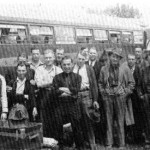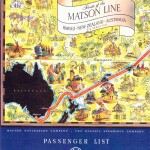The Northwest Connection
The Depression-era workers who hired on for the big prewar navy construction projects in the Pacific came from many states, but a good number hailed from the Pacific and Inland Northwest. In 1939-40 the navy contracted with a consortium of big construction companies to build naval air stations and facilities on Oahu, Palmyra, Johnston, Midway, and Wake Island (and later in the western Pacific at Guam, Cavite in the Philippines, and American Samoa). One of the eight contracting companies was Morrison-Knudsen Company, headquartered in Boise, Idaho.
Morrison-Knudsen, given primary responsibility for the contracts at Wake, Midway, and the Red Hill Underground Fuel Storage project on Oahu, initially sought highly qualified and reliable key men from their own stateside projects and snapped up recommendations from fellow construction companies in the region. M-K President Harry Morrison had a personal hand in the early hires. My grandfather, Harry Olson, and many others were hired off the Grand Coulee Dam project which was just finishing up in late 1940. These supervisors in turn reached out to hire foremen and skilled workers they knew, bringing in more men from the region.
In many cases it was not “what you know” but “who you know.” My father, Ted Olson, who had worked on Grand Coulee as a rigger but moved on to attend Washington State College in Pullman, had an “in” with his dad and got a job on Wake. He calculated that he could take a couple of semesters off and easily return with enough money to finish college, not to mention a great tan. In the Boise area, M-K itself was the connection and dozens of men found their way in via friends, family, or just a firm handshake. The California labor halls produced hundreds of skilled workers for the Pacific jobs but as mainland defense factories expanded and wages rose many opted to stay closer to home.
As the Pacific projects grew (and turnover increased), demand for workers grew. M-K established a hiring office in Boise specifically for the island contract jobs. Hiring reps fanned out through the Northwest seeking skilled, reliable workers and found them in towns big and small. Often groups of men who knew each other or had worked together were hired from the same small towns. Many were family relations: fathers and sons, brothers, cousins, or in-laws. Many didn’t know their destination until they were underway: CPNAB job orders might be filled on any of a dozen projects. CPNAB paid for travel (often first class passage on luxury liners to Honolulu), room, board, and medical coverage, and a signed contract guaranteed 9-12 months of good wages with overtime and bonus opportunities. And the crowning touch was draft deferment for the duration. A fellow risked some distance and danger, but it was a sweet deal – if he could tolerate the tropical heat and no-booze, no-women living conditions.
The roster of civilian contractors on Wake as of December 8, 1941, shows Americans from forty-three states plus Territorial Hawaii and one man from Cuba. While the numbers are approximate (and don’t necessarily reflect home towns for fellows who were, in Greg Urwin’s words, “construction gypsies”), most of the states claimed a dozen or fewer men. California came in on top with 377 men, followed by Idaho with 239 (including 119 from Boise and half a dozen from Coeur d’Alene-Rathdrum). About 122 hailed from Oregon and 70 from Washington State, the majority of them from the eastern side of the state. At least ten were hired from the tiny mining town of Metaline Falls near the Canadian border.
The outlying island projects required sea-going tugs and dredging equipment to cut through the stubborn coral reefs. The contractors’ consortium, CPNAB, purchased a giant suction dredge, the Columbia, from the Port of Portland and contracted with her captain and crew. CPNAB also chartered four powerful tugs from the Foss Company (now Foss Maritime) out of Tacoma, WA, to augment navy transportation to the outlying islands. Three of the Foss tugs plied the route between Honolulu and Wake towing huge steel barges packed with equipment and supplies. The Justine Foss remained at Wake to work the busy waterfront area and her captain and crew, including a Foss son, became contractor employees. The Arthur Foss was the last ship to depart Wake in peacetime, early on the morning of December 8, 1941. Both the Columbia and Justine Foss became casualties of the war and a number of the West Coast men who worked on them lost their lives, including the dredge captain and the Foss captain and mate, three of the 98 men massacred on Wake in 1943.
Over a period of five years CPNAB hired thousands of workers for the Pacific defense jobs and many northwest regional men and their families shared the experience. The vast majority of defense workers came home safe and many of them joined the military during the war. We honor them all for their service.
- First Class passenger list, SS Lurline, May 2, 1941 courtesy Lloyd Nelson
- New CPNAB hires departing Boise ID, March 1941 Idaho Daily Statesman



